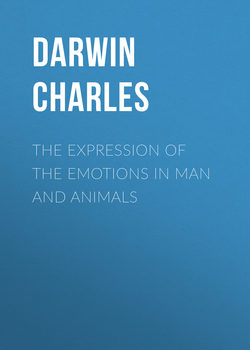The Expression of the Emotions in Man and Animals

Реклама. ООО «ЛитРес», ИНН: 7719571260.
Оглавление
Darwin Charles. The Expression of the Emotions in Man and Animals
ON THE EXPRESSION OF THE EMOTIONS IN MAN AND ANIMALS. INTRODUCTION
CHAPTER I. – GENERAL PRINCIPLES OF EXPRESSION
CHAPTER II. – GENERAL PRINCIPLES OF EXPRESSION —continued
CHAPTER III. – GENERAL PRINCIPLES OF EXPRESSION —concluded
CHAPTER IV. – MEANS OF EXPRESSION IN ANIMALS
CHAPTER V. – SPECIAL EXPRESSIONS OF ANIMALS
CHAPTER VI. – SPECIAL EXPRESSIONS OF MAN: SUFFERING AND WEEPING
CHAPTER VII. – LOW SPIRITS, ANXIETY, GRIEF, DEJECTION, DESPAIR
CHAPTER VIII. – JOY, HIGH SPIRITS, LOVE, TENDER FEELINGS, DEVOTION
CHAPTER IX. – REFLECTION – MEDITATION-ILL-TEMPER – SULKINESS – DETERMINATION
CHAPTER X. – HATRED AND ANGER
CHAPTER XI. – DISDAIN – CONTEMPT – DISGUST-GUILT – PRIDE, ETC. – HELPLESSNESS – PATIENCE – AFFIRMATION AND NEGATION
CHAPTER XII. – SURPRISE – ASTONISHMENT – FEAR – HORROR
CHAPTER XIII. – SELF-ATTENTION – SHAME – SHYNESS – MODESTY: BLUSHING
CHAPTER XIV. – CONCLUDING REMARKS AND SUMMARY
FOOTNOTES:
Отрывок из книги
The three chief principles stated – The first principle – Serviceable actions become habitual in association with certain states of the mind, and are performed whether or not of service in each particular case – The force of habit – Inheritance – Associated habitual movements in man – Reflex actions – Passage of habits into reflex actions – Associated habitual movements in the lower animals – Concluding remarks.
I WILL begin by giving the three Principles, which appear to me to account for most of the expressions and gestures involuntarily used by man and the lower animals, under the influence of various emotions and sensations.[101] I arrived, however, at these three Principles only at the close of my observations. They will be discussed in the present and two following chapters in a general manner. Facts observed both with man and the lower animals will here be made use of; but the latter facts are preferable, as less likely to deceive us. In the fourth and fifth chapters, I will describe the special expressions of some of the lower animals; and in the succeeding chapters those of man. Everyone will thus be able to judge for himself, how far my three principles throw light on the theory of the subject. It appears to me that so many expressions are thus explained in a fairly satisfactory manner, that probably all will hereafter be found to come under the same or closely analogous heads. I need hardly premise that movements or changes in any part of the body, – as the wagging of a dog's tail, the drawing back of a horse's ears, the shrugging of a man's shoulders, or the dilatation of the capillary vessels of the skin, – may all equally well serve for expression. The three Principles are as follows.
.....
A start from a sudden noise, when the stimulus is conveyed through the auditory nerves, is always accompanied in grown-up persons by the winking of the eyelids.[113] I observed, however, that though my infants started at sudden sounds, when under a fortnight old, they certainly did not always wink their eyes, and I believe never did so. The start of an older infant apparently represents a vague catching hold of something to prevent falling. I shook a pasteboard box close before the eyes of one of my infants, when 114 days old, and it did not in the least wink; but when I put a few comfits into the box, holding it in the same position as before, and rattled them, the child blinked its eyes violently every time, and started a little. It was obviously impossible that a carefully-guarded infant could have learnt by experience that a rattling sound near its eyes indicated danger to them. But such experience will have been slowly gained at a later age during a long series of generations; and from what we know of inheritance, there is nothing improbable in the transmission of a habit to the offspring at an earlier age than that at which it was first acquired by the parents.
From the foregoing remarks it seems probable that some actions, which were at first performed consciously, have become through habit and association converted into reflex actions, and are now so firmly fixed and inherited, that they are performed, even when not of the least use,[114] as often as the same causes arise, which originally excited them in us through the volition. In such cases the sensory nerve-cells excite the motor cells, without first communicating with those cells on which our consciousness and volition depend. It is probable that sneezing and coughing were originally acquired by the habit of expelling, as violently as possible, any irritating particle from the sensitive air-passages. As far as time is concerned, there has been more than enough for these habits to have become innate or converted into reflex actions; for they are common to most or all of the higher quadrupeds, and must therefore have been first acquired at a very remote period. Why the act of clearing the throat is not a reflex action, and has to be learnt by our children, I cannot pretend to say; but we can see why blowing the nose on a handkerchief has to be learnt.
.....